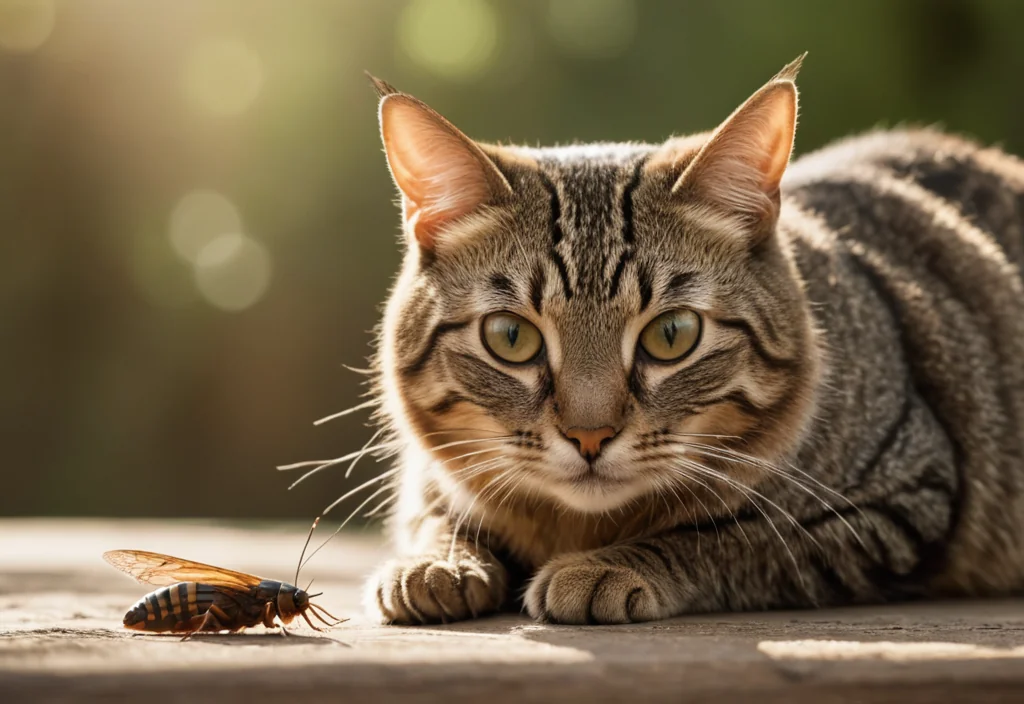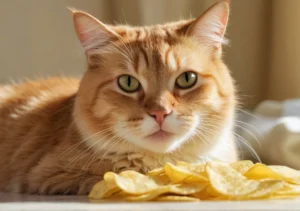Cats are curious little hunters, and when they chase after cicadas, it can leave pet parents wondering why. These noisy insects seem to attract cats like magnets, creating a spectacle of pouncing and playful antics in the yard.
Cats eat cicadas primarily because they are instinctual hunters, and these crunchy bugs offer a source of entertainment and nutrition. But the reasons don’t stop there—there’s a fascinating interplay of instinct, taste, and environment that makes this behavior even more intriguing. Keep reading, and you might discover some surprising insights about your feline friend’s peculiar snack choices.

What draws cats to cicadas
Cats are naturally curious and instinctual hunters. The sound of cicadas buzzing in the summer air can be hard for them to resist. Their sharp vision and quick reflexes make catching these larger-than-average insects exhilarating. Additionally, cicadas often appear in large numbers, giving your feline friend a smorgasbord of movement that stimulates their predatory instincts.
Moreover, there’s a strong element of play in this behavior. Cats often see hunting as a game, and cicadas flitting around become the perfect chase partner. The joy on your cat’s face when they pounce on a cicada is a combination of instinctive behavior and sheer fun. It’s not just about appetite; it’s about engaging with their environment and fulfilling that chase-and-catch urge. Cats are also protein-driven eaters, and cicadas, being rich in protein, fit nicely into their dietary needs.
Are cicadas safe for cats to eat
Cicadas are generally considered safe for cats to nibble on. They’re low in calories and packed with protein, making them a pretty decent snack option. However, a few things are worth keeping in mind:
-
Pesticides and Chemicals : If cicadas have been exposed to pesticides or other chemicals, consuming them could pose health risks. Always ensure your cat is chasing cicadas from safe, untreated areas.
-
Choking Hazard : Cicadas have hard exoskeletons that can be tough to digest and may choke a small or inexperienced cat. Monitor your cat if they decide to munch on one.
-
Allergies : While rare, some cats may develop allergies to certain insects, including cicadas. Watch for signs of distress, such as vomiting or excessive scratching.
-
Moderation is Key : Too much of anything isn’t great, right? While a few cicadas won’t hurt, it’s best to keep it as an occasional treat rather than a meal replacement.
If you’re interested in a deeper dive into the nutritional aspects of cicadas for pets, a resource like the ASPCA can provide more insights on safe insect consumption. Their website offers great information about common pet concerns. Check out ASPCA Pet Care for helpful tips.
Being aware of these factors can help you appreciate this quirky feline habit while keeping your kitty safe and healthy.
How do cicadas taste to cats
Cicadas might seem a bit strange for a cat’s snack, but to them, these critters can be quite a treat. Flavor is key; many cats are instinctively attracted to high-protein foods, and cicadas pack a punch in that department. Cats are obligate carnivores, meaning their diets rely heavily on meat, and that includes crunchy insects like cicadas.
The texture also plays a role—these critters are crunchy on the outside but soft on the inside, which can be quite appealing to a cat that enjoys a good crunch. Their exoskeletons give that satisfying crack when bitten into, which may engage a cat’s playful hunting instincts. Besides, cicadas are often easier to catch when they’re buzzing around on a hot summer day, making them a fun and enticing target for your feline friend.
In some cases, the scent can be attractive to cats, too. Cicadas have a distinct smell that may draw your cat in as they roam around, especially during mating festivals when they swarm in numbers. All of this combines to make a cicada not only appetizing but also an engaging pursuit for our curious companions.
Is it common for all cats to eat cicadas
While cicada munching is a fascinating behavior, not all cats are created equal in this department. Some cats may devour cicadas with gusto, while others might sniff them out and walk away. Several factors influence whether a cat takes the plunge.
-
Playfulness : Cats that are more playful are likely to hunt here and there, which increases their chances of eating a cicada.
-
Diet : If your cat’s regular diet lacks variety or is less protein-rich, they might be more inclined to snack on insects as a natural supplement.
-
Exposure : Cats that spend time outdoors or have access to insect-rich environments may become more accustomed to catching and eating cicadas.
-
Age : Younger cats, often more curious and energetic, may be more inclined to chase and eat cicadas compared to their older, more settled counterparts.
-
Genetics : Some breeds have stronger hunting instincts, making them more likely to engage with cicadas and other insects compared to more docile breeds.
Lastly, it’s worth noting that while cicadas are generally safe for cats to eat in moderation, excessive eating of any wild insects could lead to digestion issues. If your cat seems overly enthusiastic about their new snack, it’s good to keep an eye on how they’re handling it. Here’s a bonus tip: if you spot your cat snacking on cicadas, make sure there aren’t any pesticides in the vicinity that could harm them.
For more insights into what your cat should and shouldn’t eat, you can check out the American Society for the Prevention of Cruelty to Animals (ASPCA).
What nutritional benefits do cicadas provide to cats
Cicadas might seem like an odd snack, but they pack a surprising nutritional punch. High in protein, these insects can contribute essential amino acids that support your cat’s muscle development and overall energy levels. Along with protein, cicadas contain a variety of vitamins and minerals, such as B vitamins, which are crucial for energy metabolism, and zinc, which plays a role in immune function.
Additionally, cicadas are low in carbohydrates and rich in healthy fats, offering a well-rounded treat that aligns with your cat’s carnivorous nature. This combination of nutrients can satisfy your cat’s instinctive hunting behavior while offering a crunchy, satisfying snack.
However, moderation is key! While they offer some benefits, cicadas shouldn’t replace a balanced cat diet. Always check for any signs of allergies or digestive issues after your cat snacks on these critters.
How to discourage your cat from eating cicadas
If you’re not keen on sharing your yard with cicadas or your cat’s unusual cravings, there are some effective strategies to keep them at bay.
-
Limit outdoor access: Keep your cat indoors, especially during cicada season. This way, they won’t be tempted to munch on these insects.
-
Create distractions: Offer engaging toys or play sessions. Keeping your cat entertained can lessen their interest in searching for bugs.
-
Use cat-safe deterrents: Spraying areas where cicadas gather with a pet-safe deterrent may discourage your cat from lingering there.
-
Provide alternative snacks: Treat them with commercially available cat treats that are just as enticing but more nutritious.
-
Supervise outdoor time: If your cat does go outside, keep an eye on them to prevent them from snatching cicadas.
Also, if your cat insists on catching cicadas, consider training them to respond to commands like “no” or “leave it.” This can help you manage their behavior effectively.
For more detailed guidance on cat behavior, check out the American Society for the Prevention of Cruelty to Animals (ASPCA) here.
What should you do if your cat eats too many cicadas
Cats might find cicadas irresistible due to their crunchy texture and natural instinct to hunt, but too many can lead to some tummy troubles. If you notice your cat indulging a bit too much, there are several steps you should take:
-
Monitor for symptoms : Keep an eye on your cat for any signs of distress, such as vomiting, diarrhea, or lethargy. These could indicate an upset stomach.
-
Limit access : If your kitty’s a persistent cicada catcher, consider restricting outdoor time during peak cicada activity. A well-timed indoor play session can satisfy their hunting instinct.
-
Hydration is key : Ensure your cat has plenty of fresh water available. Staying hydrated can help prevent any potential digestive issues.
-
Contact the vet : If your cat seems unwell or you’re concerned about their intake, reaching out to your veterinarian is always wise. They can offer tailored advice based on your cat’s health needs.
-
Watch for allergies : Some pets can have sensitivities to insects. Keep an eye out for signs of allergic reactions, such as itching or swelling.
Offering plenty of indoor entertainment, like toys that mimic their hunting instincts, can help channel their energy away from those tasty cicadas.
Fun cicada trivia for cat lovers
Cicadas might just be a passing snack for your feline, but they’re fascinating insects that play an important role in nature.
-
Life cycle marvel : Cicadas spend years underground—some species up to 17 years—before emerging to sing, mate, and eventually lay eggs. This means your cat’s cicada hunt is tapping into a fascinating natural phenomenon.
-
Soundtrack of summer : Those chirpy sounds you hear? That’s the male cicada’s mating call. So, next time your cat gets excited, they might be just as entranced by the symphony of cicadas as they are by their meal.
-
Cicadas are eco-friendly : When cicadas die after mating, they decompose and add vital nutrients back into the soil. This enriches the earth, supporting plant life and, ultimately, the entire ecosystem.
-
Snack of champions : Certain cultures consider cicadas a delicacy, packed with protein. They can be fried, baked, or even used in protein bars, showing that these insects are more than just cat food.
-
Ecosystem balance : By preying on cicadas, cats help control their population, balancing the local ecosystem. This makes your little predator part of nature’s intricate web.
Engaging with cicadas can be a quirky bonding experience. If your cat loves them, you might as well dive into the fascinating world of these remarkable insects alongside them! For additional insights on cicadas’ ecological roles, check out the National Geographic article.
When do cicadas typically appear
Cicadas are fascinating little critters that usually emerge in the warmer months, creating a concert of sounds in the background of summer. In the U.S., especially in the eastern states, periodical cicadas appear in cycles, typically every 13 or 17 years. The most famous of these is the Brood X, which last emerged in 2021 and won’t return until 2038.
However, annual cicadas pop up more frequently. Depending on where you live, you can expect to see them from late spring through early fall—essentially from May to September. It’s the warmer temperatures that drive their emergence, allowing them to thrive and mate. They’re quite active during sunny days, particularly during the late afternoon.
Pet owners might notice the presence of cicadas when they hear that distinct buzzing sound or find the critters crawling around. Your cat may be intrigued by that noise and movement, leading them to snack on these crunchy insects.
Key Factors for Cicada Activity:
- Temperature: Warmer temperatures signal emergence.
- Time of Year: Late spring to early fall is peak cicada season.
- Species: Understand the difference between periodical and annual cicadas.
As a bonus tip, if you notice cicadas in your backyard, it’s a good opportunity to keep your cat engaged outdoors. Just monitor their behavior to ensure they’re not overindulging!
Alex, a passionate animal lover, has experience in training and understanding animal behavior. As a proud pet parent to two dogs and three cats, he founded AnimalReport.net to share insights from animal experts and expand his knowledge of the animal kingdom.




